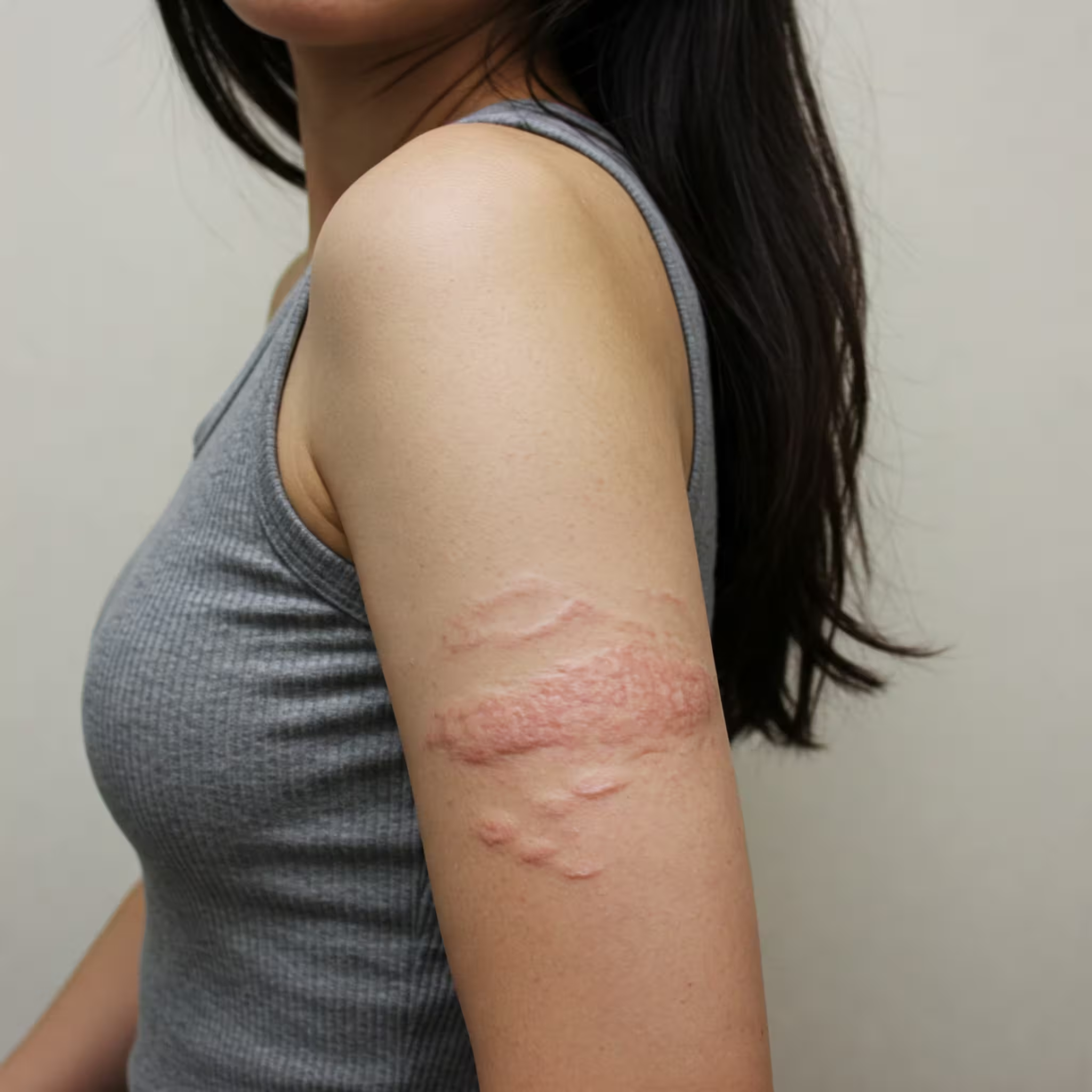What Are Keloid Scars?
Keloid scars are raised overgrowths of scar tissue that develop at the site of a skin injury and extend beyond the boundaries of the original wound. Unlike normal scars that typically flatten and fade over time, keloids continue to grow and may become significantly larger than the initial injury.
These distinctive scars form when there is an overproduction of collagen during the wound healing process. They usually appear as smooth, hard, raised tissue with a shiny surface and can range in color from pink to red, purple, or darker than the surrounding skin.
As they mature, keloids often darken with time.
Beyond their cosmetic appearance, keloids can cause physical symptoms including:
- Itchiness
- Pain or tenderness
- A burning sensation
- Tightness that may restrict movement (particularly if located near joints)
Common Locations and Causes
Keloids most commonly form on the:
- Chest
- Shoulders
- Upper back
- Earlobes
- Jawline
- Arms
They typically develop following some form of skin trauma, such as:
- Surgical incisions
- Ear piercings
- Vaccinations
- Acne
- Burns
- Cuts and scratches
- Body piercings
- Tattoos
However, keloids can sometimes develop spontaneously without any obvious trauma to the skin.
Causes of Keloid Scars
While anyone can develop keloids, certain factors increase the risk:
- Genetic factors: People of south Asian, Chinese, African Caribbean or Black African origin are more likely to develop keloids compared to those with lighter skin tones.
- Age: Keloids are most common between the ages of 10 and 30, with lower prevalence in children and the elderly.
- Family history: A genetic predisposition to keloid formation may run in families.
- Location of injury: Areas with high skin tension like the chest, shoulders, and upper back are more prone to keloid formation.
- Hormonal factors: Some women notice keloid development or enlargement during pregnancy.
The Science Behind Keloid Formation
To understand keloids, it helps to know the normal wound healing process, which occurs in four main stages:
- Hemostasis Phase: Immediately after injury, platelets form a clot to stop bleeding.
- Inflammatory Phase: Immune cells clean the wound by removing debris and pathogens while releasing growth factors for tissue repair.
- Proliferative Phase: The body fills the wound with connective tissue and forms new blood vessels. The wound margins contract toward the center and are covered with epithelium.
- Maturation Phase: Collagen fibers reorganize, and skin tissue remodels to restore strength and elasticity.
Keloid formation typically occurs during stages 3 and 4 due to:
- Excessive tissue and collagen production during the Proliferative phase
- Improper reorganization of collagen fibers during the Maturation phase
Keloids vs. Hypertrophic Scars
It’s important to distinguish between keloids and hypertrophic scars, as they require different approaches to treatment:
| Feature | Keloid | Hypertrophic Scar |
|---|---|---|
| Appearance | Larger than the original wound, can be red, dark, or discolored with a shiny, smooth surface | Raised and reddish but remains within the edges of the original wound; often firm and less smooth |
| Growth Pattern | Continues to grow over time, often enlarging well beyond the original injury site | Grows within the boundaries of the original wound and may improve or flatten over time |
| Treatment Response | May be resistant to treatment and can recur even after successful treatment | Typically responds well to treatment and may improve significantly over time |
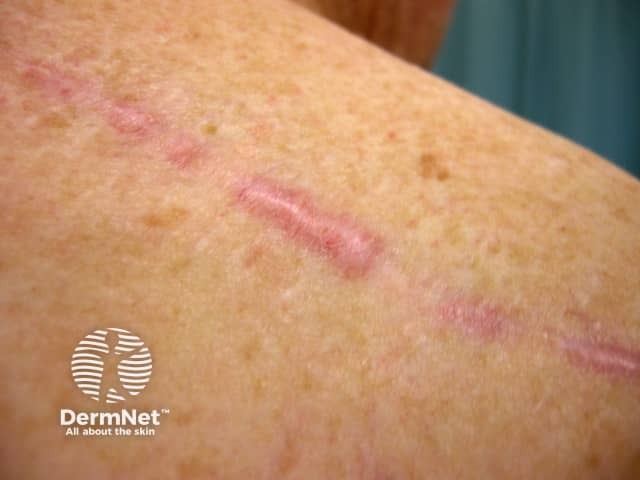
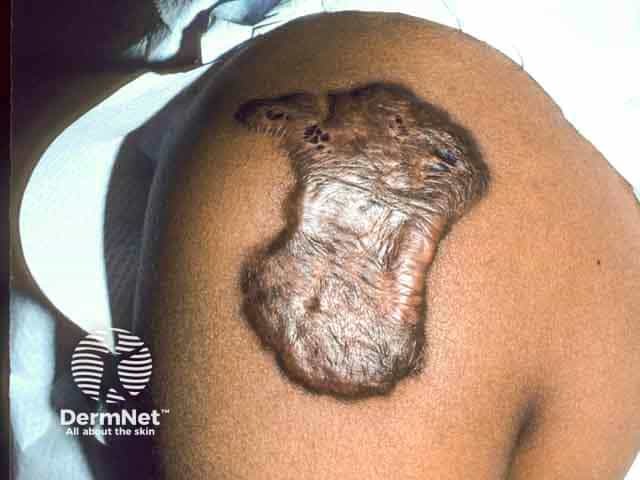
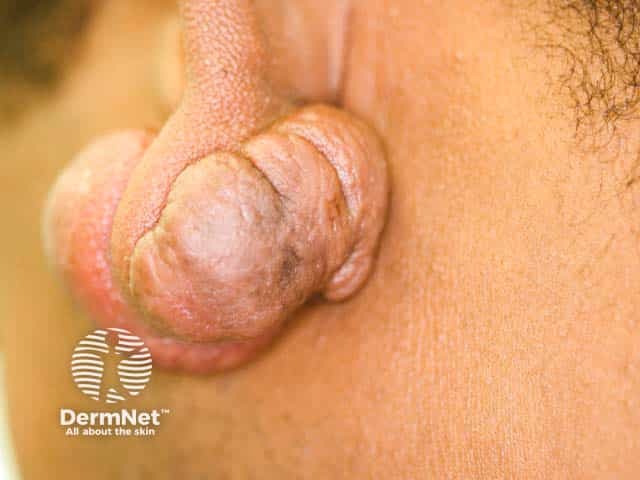
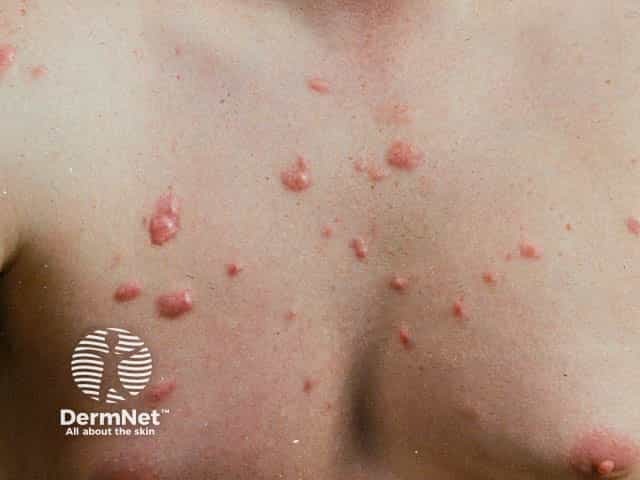
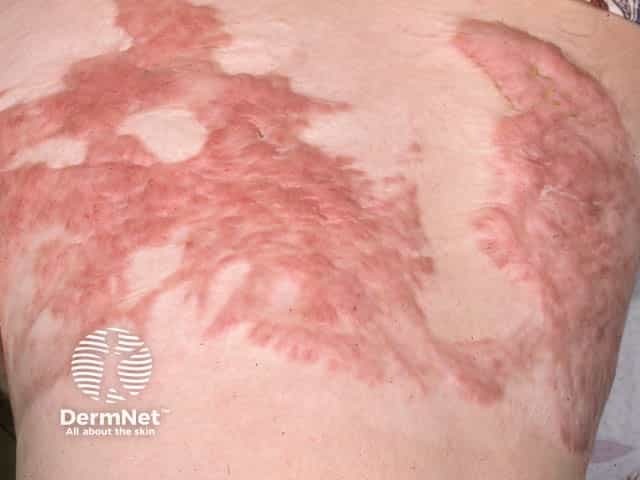

Why You Should Treat Keloids
While keloids are generally not dangerous to your health, there are several compelling reasons to seek treatment:
- Pain and Discomfort: Keloids can cause itchiness, pain, and discomfort that interferes with daily activities.
- Preventing Growth: Without treatment, keloids can continue to grow larger over time.
- Cosmetic Concerns: The visible appearance of keloids can cause emotional distress, particularly when they form in exposed areas like the face or arms.
- Risk of Infection: Keloids can trap hair follicles, potentially leading to infection and inflammation.
- Improved Quality of Life: Managing keloids can improve social interactions, professional engagement, and enhance self-confidence.
When to Start Treatment
A common misconception is that scars should be allowed to “mature” for 6-12 months before treatment. However, current evidence contradicts this belief:
Early treatment leads to better outcomes. Treating scars as early as 2-3 weeks after the stitches are removed (for surgical scars) can result in less obvious scarring and improved cosmetic results.
For patients with a history of keloid formation, preventive treatments can be started immediately after wound closure to minimize the chance of keloid development.
Can Old Keloids Be Treated?
Yes, even scars from 20 years ago can be improved, especially if they are raised or depressed. Discolored scars that leave brown or pink marks can also be effectively treated.
However, very old scars that are flat and white tend to be the most difficult to treat successfully.
Treatment Options for Keloid Scars in Singapore
1. Intralesional Steroid Injections
This is one of the most common first-line treatments:
- A corticosteroid solution is injected directly into the keloid
- The steroid breaks down the bonds between dense collagen fibers
- It reduces inflammation, itching, and pain
- Multiple sessions at 4-6 week intervals are typically needed
- Success rate is higher when combined with other treatments
How it works: Steroids have potent anti-inflammatory properties that help reduce swelling, redness, and itching. They also suppress collagen production and flatten the scar over time.
2. Laser Therapy
Several types of laser treatments are effective for keloids:
Pulsed Dye Laser (VBEAM)
- Targets the blood vessels in the keloid
- Reduces redness and blood supply to the area
- Particularly effective for red acne marks and fresh keloids
- Visible lightening can occur after just a few sessions
Fractional CO2 Laser
- Creates microscopic channels in the skin
- Stimulates collagen remodeling
- Helps flatten and improve the texture of the scar
- Can be combined with topical treatments for enhanced penetration
- Typically requires 4-5 monthly treatments
CO2 Laser Excision
- Alternative to surgical excision
- Minimizes trauma to surrounding tissue
- Must be combined with other treatments to prevent recurrence
3. Cryotherapy
- Uses liquid nitrogen to freeze the keloid at -120°C
- Helps soften and reduce the size of the keloid
- May cause discomfort during treatment
- Can cause pigmentation changes, especially in darker skin
4. Silicone Gel Sheets and Gels
- Applied directly to the scar
- Works through occlusion and hydration of the skin
- More effective for prevention than treatment of established keloids
- Should be worn at least 12 hours daily for 2-3 months
5. Pressure Therapy
- Uses bandages, garments, or even micropore tape
- Pressure reduces collagen bundles from sticking together
- Best applied for 8-12 weeks during healing
- Most effective for prevention rather than treatment
6. Surgical Excision (with Adjunctive Therapy)
Surgical treatment alone has a high recurrence rate (up to 60%), but when combined with other treatments, it can be effective:
- The keloid is surgically removed
- Wound edges are carefully aligned without tension
- Followed by adjunctive treatments like:
- Immediate radiotherapy
- Steroid injections
- Pressure therapy
Note: Surgery is usually considered only after other treatments have failed, particularly for large or problematic keloids.
7. Radiotherapy
- Often used in combination with surgical excision
- Targets the DNA of scar-forming cells
- Controls growth and prevents keloid formation
- Must be performed by experienced specialists
- Typically involves daily sessions for several days following surgery
8. Emerging Treatments
Botulinum Toxin (Botox) Injections
- May improve keloid appearance and reduce symptoms
- Works by reducing fibroblast activity and tension around the wound
- Avoids side effects associated with steroid injections
- Research is still ongoing
Laser-Assisted Drug Delivery
- Combines laser technology with enhanced drug penetration
- Creates micro-channels in the skin for better absorption of medications
- Leads to more significant reduction in keloid size and improved texture
Combination Approaches
Most dermatologists in Singapore recommend combination therapy for optimal results. Common combinations include:
- Steroid injections + pulsed dye laser
- Surgical excision + immediate radiotherapy
- Cryotherapy + steroid injections
- CO2 laser + steroid injections (especially for earlobe keloids)
For deeply depressed scars, additional options include:
- TCA CROSS treatment (trichloroacetic acid chemical reconstruction of skin scars)
- Surgical removal of deeper scars followed by fractional CO2 laser resurfacing
What to Expect During Treatment
Pain Management
Most keloid treatments are well-tolerated with minimal discomfort:
- Numbing cream is usually applied 30-45 minutes before laser treatments
- Steroid injections may cause discomfort similar to an ant bite
- Subsequent treatments are typically less painful as the scar softens
Downtime
- After treatments like laser therapy or injections, you may experience swelling, redness, and itchiness on the treated area
- These symptoms typically subside within a few days
- Improvement in keloid size and color usually becomes visible within weeks
Number of Sessions
- Multiple treatment sessions are typically required
- Sessions are usually spaced 4-6 weeks apart
- The exact number depends on the size, age, and response of the keloid
Preventing Keloid Formation
If you’re prone to keloids, consider these preventive measures:
- Avoid unnecessary skin trauma such as tattoos, piercings, or elective surgeries, especially in high-risk areas like the chest or shoulders.
- Treat acne early and effectively to prevent the formation of acne scars that could develop into keloids.
- Use silicone gel sheets or silicone gel immediately after wound closure, especially if you have a history of keloid formation.
- Consider prophylactic steroid injections after surgery if you have a history of keloid formation.
- Apply pressure to healing wounds with micropore tape for 8-12 weeks in areas prone to keloid formation.
Managing Expectations
It’s important to have realistic expectations about keloid treatment:
- Complete removal may not always be achievable
- Keloids can recur even after successful treatment
- Multiple treatment sessions are usually necessary
- Early intervention generally yields better results
- The treatment process requires patience and commitment
Cost of Keloid Treatment in Singapore
Treatment costs vary depending on several factors:
- Type of treatment
- Size and location of the keloid
- Number of sessions required
- Experience of the doctor
In Singapore, approximate costs include:
- Initial consultation: $160-200
- Steroid injections: from $200 per session
- Vascular laser: from $399 per session
- Fractional laser: from $399 per session
- Laser assisted drug delivery: from $459 per session
Some treatments may be insurance reimbursable, particularly if deemed medically necessary rather than cosmetic.
FAQs About Keloid Scar Removal in Singapore
How painful is keloid scar removal?
Most keloid treatments are well-tolerated with minimal discomfort. Topical numbing cream is usually applied before procedures to maximize comfort. Steroid injections may cause a brief stinging sensation similar to an ant bite, but subsequent treatments typically become less painful as the scar softens.
What is the recovery process like after keloid treatment?
Recovery depends on the treatment method. After injections or laser therapy, you may experience temporary redness, swelling, and itchiness that typically subsides within a few days. Surgical removal requires 1-2 weeks for wound healing. Most treatments have minimal downtime, allowing you to resume normal activities immediately.
Will my keloid come back after treatment?
There is always a risk of recurrence with keloid treatment. Following proper aftercare instructions and completing the full recommended treatment course helps reduce this risk. Combination therapies generally have lower recurrence rates than single-treatment approaches.
How many treatment sessions will I need?
Most keloids require multiple treatment sessions for optimal results. The exact number depends on the size, age, and location of the keloid, as well as your individual response to treatment. Typically, treatments are spaced 4-6 weeks apart, and a series of 4-5 sessions may be needed.
Can pregnant women undergo keloid treatment?
Some keloid treatments, particularly steroid injections and certain medications, are not recommended during pregnancy. Consult with your dermatologist about safe options if you’re pregnant or planning to become pregnant.
Is radiotherapy for keloids safe?
Despite concerns about radiation, the radiotherapy used for keloids is carefully controlled with precise, low dosages targeted specifically at the treatment area. The rest of the body is shielded to prevent unnecessary exposure. When performed by experienced specialists, it’s considered safe with minimal risk of complications.
Does insurance cover keloid treatment in Singapore?
Some keloid treatments may be covered by insurance if they’re deemed medically necessary (causing pain or restricting movement) rather than purely cosmetic. Check with your insurance provider about specific coverage details.
What is the best age to treat keloids?
There’s no specific age restriction for keloid treatment. However, early intervention generally leads to better outcomes. Children and teenagers with keloids can be treated, though the approach may be modified based on age and the location of the keloid.
Is laser treatment or steroid injection better for keloids?
Neither is universally “better” – the most effective approach depends on your specific keloid and often involves combining both treatments. Steroid injections help reduce inflammation and flatten the scar, while lasers can address redness and improve texture. Your dermatologist will recommend the best combination for your situation.
Can I use over-the-counter creams instead of professional treatment?
Over-the-counter silicone gels and sheets may help prevent keloid formation or treat very minor keloids, but established keloids typically require professional medical treatment for significant improvement. Consult a dermatologist for proper diagnosis and treatment.
Conclusion
Keloid scars can be both physically uncomfortable and emotionally distressing. The good news is that with modern treatment options available in Singapore, most keloids can be significantly improved through proper medical intervention.
Remember that early treatment yields better results, but even older scars can be successfully treated. The key to successful keloid management is a personalized treatment plan, often combining multiple approaches, and a commitment to following through with the complete treatment regimen.
If you’re struggling with keloid scars, consult a dermatologist who specializes in scar management to discuss the most appropriate treatment options for your specific situation.

